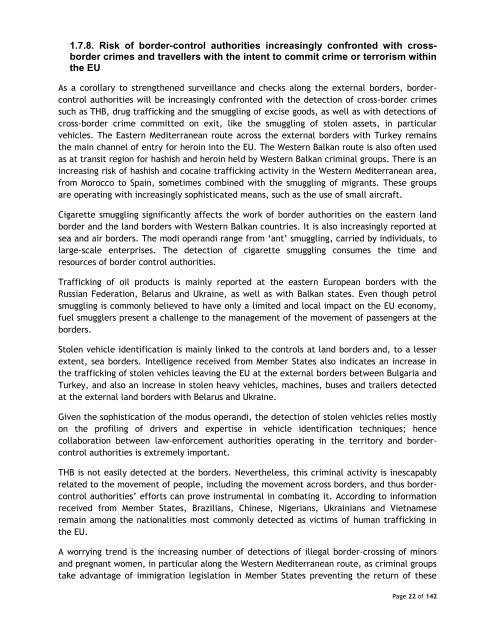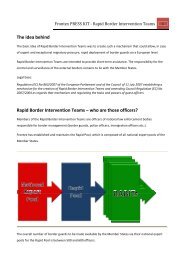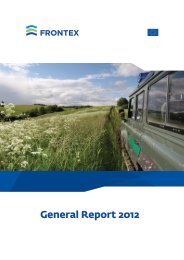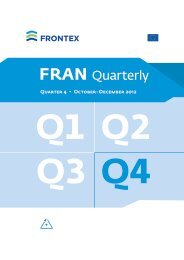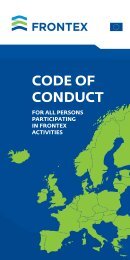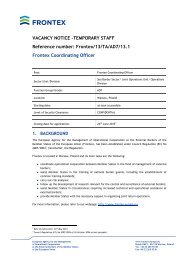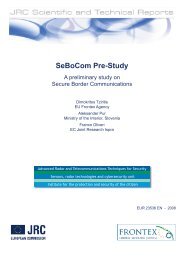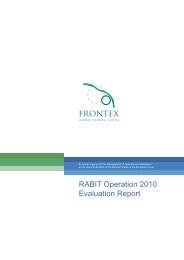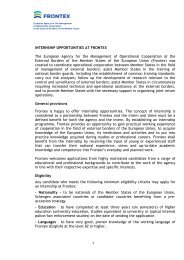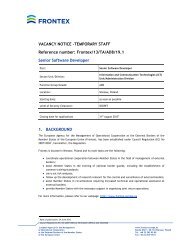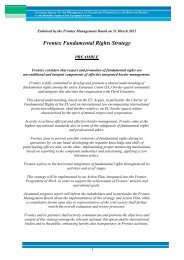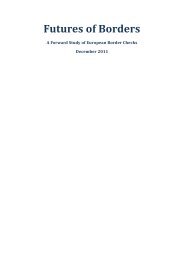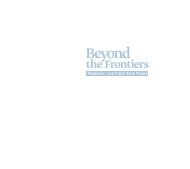Download PDF - Frontex
Download PDF - Frontex
Download PDF - Frontex
You also want an ePaper? Increase the reach of your titles
YUMPU automatically turns print PDFs into web optimized ePapers that Google loves.
1.7.8. Risk of border-control authorities increasingly confronted with crossborder<br />
crimes and travellers with the intent to commit crime or terrorism within<br />
the EU<br />
As a corollary to strengthened surveillance and checks along the external borders, bordercontrol<br />
authorities will be increasingly confronted with the detection of cross-border crimes<br />
such as THB, drug trafficking and the smuggling of excise goods, as well as with detections of<br />
cross-border crime committed on exit, like the smuggling of stolen assets, in particular<br />
vehicles. The Eastern Mediterranean route across the external borders with Turkey remains<br />
the main channel of entry for heroin into the EU. The Western Balkan route is also often used<br />
as at transit region for hashish and heroin held by Western Balkan criminal groups. There is an<br />
increasing risk of hashish and cocaine trafficking activity in the Western Mediterranean area,<br />
from Morocco to Spain, sometimes combined with the smuggling of migrants. These groups<br />
are operating with increasingly sophisticated means, such as the use of small aircraft.<br />
Cigarette smuggling significantly affects the work of border authorities on the eastern land<br />
border and the land borders with Western Balkan countries. It is also increasingly reported at<br />
sea and air borders. The modi operandi range from ‘ant’ smuggling, carried by individuals, to<br />
large-scale enterprises. The detection of cigarette smuggling consumes the time and<br />
resources of border control authorities.<br />
Trafficking of oil products is mainly reported at the eastern European borders with the<br />
Russian Federation, Belarus and Ukraine, as well as with Balkan states. Even though petrol<br />
smuggling is commonly believed to have only a limited and local impact on the EU economy,<br />
fuel smugglers present a challenge to the management of the movement of passengers at the<br />
borders.<br />
Stolen vehicle identification is mainly linked to the controls at land borders and, to a lesser<br />
extent, sea borders. Intelligence received from Member States also indicates an increase in<br />
the trafficking of stolen vehicles leaving the EU at the external borders between Bulgaria and<br />
Turkey, and also an increase in stolen heavy vehicles, machines, buses and trailers detected<br />
at the external land borders with Belarus and Ukraine.<br />
Given the sophistication of the modus operandi, the detection of stolen vehicles relies mostly<br />
on the profiling of drivers and expertise in vehicle identification techniques; hence<br />
collaboration between law-enforcement authorities operating in the territory and bordercontrol<br />
authorities is extremely important.<br />
THB is not easily detected at the borders. Nevertheless, this criminal activity is inescapably<br />
related to the movement of people, including the movement across borders, and thus bordercontrol<br />
authorities’ efforts can prove instrumental in combating it. According to information<br />
received from Member States, Brazilians, Chinese, Nigerians, Ukrainians and Vietnamese<br />
remain among the nationalities most commonly detected as victims of human trafficking in<br />
the EU.<br />
A worrying trend is the increasing number of detections of illegal border-crossing of minors<br />
and pregnant women, in particular along the Western Mediterranean route, as criminal groups<br />
take advantage of immigration legislation in Member States preventing the return of these<br />
Page 22 of 142


